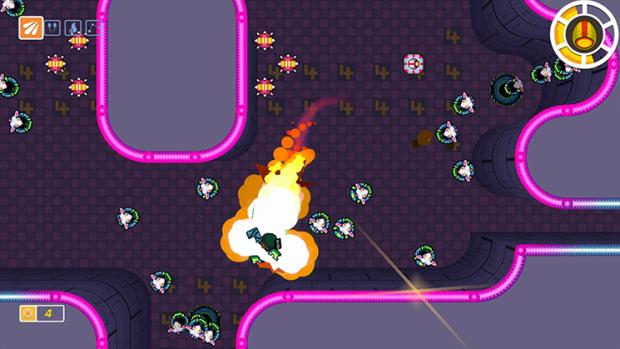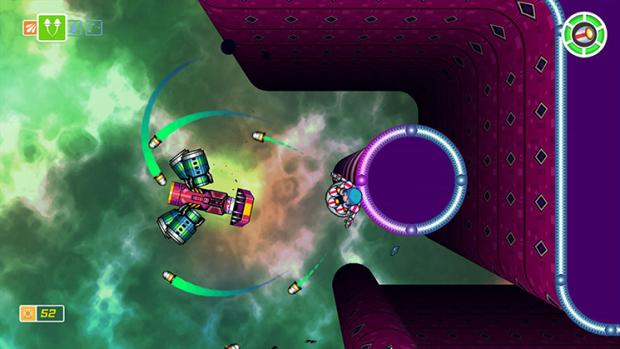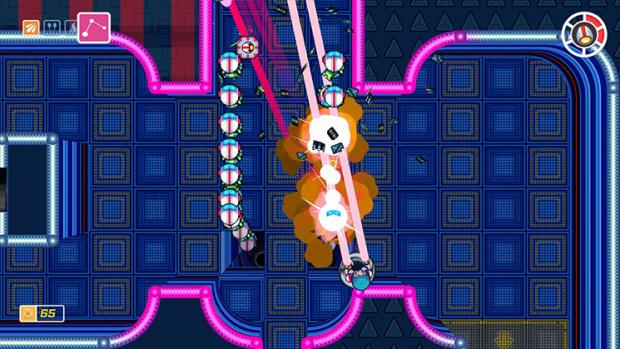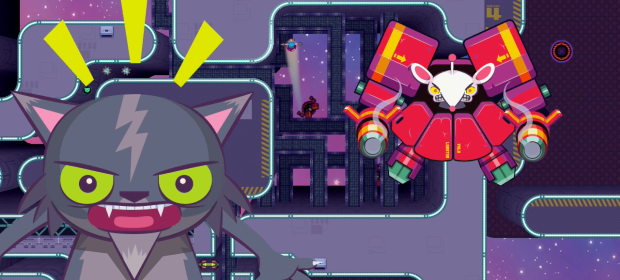Scram is south wales slang for a cat scratch, so says Scram Kitty lead designer and founder of Dakko Dakko Rhodri Broadbent. That means that the title of this game is actually cat scratch kitty, or scratch kitty for short. It’s an apt warning: Scram Kitty and his Buddy on Rails stings.
But it stings in a good way. Scram Kitty and his Buddy on Rails is a tough game, you see, born from the ideologies of the NES and SNES, asking the player for perfection in play lest they feel the scratch and sting of the failure and restart. Much like a real cat, then, this kitty has claws.
And perfection won’t come easy, largely thanks to the game’s wonderfully unique gameplay. Part platformer, part shooter, Scram Kitty and his Buddy on Rails casts you as the buddy on rails, riding your spinboard – part skateboard, part magnetic discus – along the walls of a gigantic space station, shooting outwards at the pesky cat-kidnapping super mice that are trying to halt your attempts to rescue the titular scratch cat.

It takes a little chunk of time to acknowledge just what’s going on simply because Scram Kitty is rather unlike anything you’ll have encountered in the past. Movement around the levels demands that you trace the walls with the stick or d-pad, an initially alien concept but one that, like much of Scram Kitty, becomes satisfying with practise.
As well as grinding the rails you can jump, but you’ll always magnetise back onto the rail you leapt from unless you practically touch another with your arc. You can bounce on a rail for the flaming bounce to attack and go further, too, but this brings a list of extra precautions and considerations with it. And of course you can shoot, but only in a straight line away from the rail.
Not only are you trying to understand how to play a shooter from a linear path, you’re also experimenting with gravitational pulls, worrying about constantly shifting shot trajectories, trying to avoid waves of enemy fire and work out how to use your limited skillset to deal with the plague of enemies trying to eject you from your rail while searching for the stage’s conclusion, all without dying.

Yet because Scram Kitty is so unique, this is what makes it so enjoyable to play. This is a new game, a different game to what you’ve experienced in this genre before, and it’s so beautifully constructed that, once it clicks, it clicks. Sure your arm will be riddled with angry, glowing injuries from the countless teething failures, but achieving perfection and playing Scram Kitty well is such an absolute delight that the pain is worth it.
There’s an arcade beauty to it. Tracing the wall with your left thumb has a Pac-Man like satisfaction as practise sees you glide around the arcs and twists of a level, while nailing pesky mech mice with precise shots from your locked angle has distinct echoes of classics like Space Invaders and Galaxian, albeit with a thoroughly modern flavour.
But it’s when you start to get really good, when you start feeling those “perfect run” vibes (something you’ll need in the timed Challenge mode, where you must go from level 1 to the end within a time limit) that Scram Kitty and his Buddy on Rails becomes a beautiful game. A game where motion is never ending, where brave slingshots around gravity sources are used to rescue kitties more efficiently and without error. Where you navigate a maze that once stumped you with the grace of a ballistic ballerina. Scram Kitty is a game that doesn’t just demand that you learn to play it well, it’s a game that makes playing it well a unique joy. Similar to a classic shooter like Ikaruga, or a speed platformer like Donkey Kong Country Tropical Freeze, Scram Kitty and his Buddy on Rails has that engrossing vibe and those perfect controls that make playing well its own reward.

If a criticism must be levelled at Scram Kitty, then the Wii U implementation isn’t truly integral to the title despite the use of the second screen being quite fun. You play on the Gamepad (or TV; it can be swapped) while the TV shows a cinematic view of the action, with Scram Kitty rearing his cute anime face to offer hints and provide “wider” views of the game’s tougher moments. It’s not essential – the designer describes it more as a spectator view – but I can attest to having an onlooker offer advice during gameplay that was genuinely helpful, creating a pseudo co-op experience. Again, not essential, but interesting.
If you wanted to level another complaint, it’s that some may call it “short”. It will take roughly 5-6 hours to rescue Scram Kitty, and about 8-9 to rescue every cat – each level contains four cats, one for reaching the level exit, one for defeating a level’s mouse commander, one for collecting 100 pennies, and another you have to chase around the stage. With that said, the extra challenge mode truly evokes the game’s retro heritage, and provides a task so tough it will extend the game’s life many times over for the dedicated.
It would have been easier for Dakko Dakko to create twice the content at half the quality, but instead Scram Kitty and his Buddy on Rails is a game in which no level, challenge, enemy or mechanic feels surplus or overused. Every level has something that helps it standout and feel unique, and it’s the combination of strong stage variety with unique, taut and enthralling controls that makes Scram Kitty such a superb game to play.
VERDICT: Kitties have claws, and kitties scratch. Scram Kitty and his Buddy on Rails certainly does this through its difficulty and unique controls. Yet cats also have a unique trait: for all their peculiar habits, their demanding nature and their tendency to puke in the hallway overnight, they’re inescapably lovable because of what they are. Scram Kitty and his Buddy on Rails, with its strange design and riveting gameplay, echoes this side of the feline personality, too. Captivating stuff.

SUPERB. This is the mark of greatness, only awarded to games that engage us from start to finish. Titles that score 9/10 will have very few problems or negative issues, and will deliver high quality and value for money across all aspects of their design.






